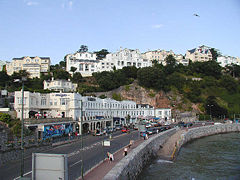Torquay
| Torquay | |
|
|
|
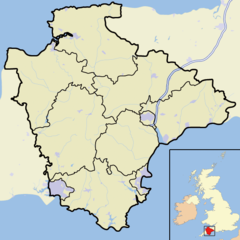 Torquay shown within Devon |
|
| Population | 63,998[1] (2001 Census) |
|---|---|
| OS grid reference | |
| Unitary authority | Torbay |
| Ceremonial county | Devon |
| Region | South West |
| Constituent country | England |
| Sovereign state | United Kingdom |
| Post town | TORQUAY |
| Postcode district | TQ1, TQ2 |
| Dialling code | 01803 |
| Police | Devon and Cornwall |
| Fire | Devon and Somerset |
| Ambulance | South Western |
| European Parliament | South West England |
| UK Parliament | Torbay |
| List of places: UK • England • Devon | |
Torquay (pronounced /tɔrˈkiː/) is a town in the unitary authority of Torbay and ceremonial county of Devon, England.
It lies 16 miles (26 kilometres) south of Exeter along the A380 on the north of Torbay, 38 miles (61 km) north-east of Plymouth and adjoins the neighbouring town of Paignton on the west of the bay. Torquay’s population of 63,998 during the 2001 UK Census made it the third largest settlement in Devon. If the Torbay area, of which Torquay forms a third, were to be recognised as a city as incumbent Torbay Mayor Nicholas Bye has proposed, it would rank as the 45th largest city in the United Kingdom with a population only slightly less than that of Brighton, which was granted city status in 2000. During the peak summer season the resort's population swells to around 200,000 [2]
The town's economy was initially based upon fishing and agriculture as in the case of Brixham across Torbay, but in the early 19th century the town began to develop into a fashionable seaside resort, initially frequented by members of the Royal Navy during the Napoleonic Wars while the Royal Navy anchored in the bay and later by the crème de la crème of Victorian society as the town's fame spread. Renowned for its healthful climate, the town earned the nickname of the English Riviera and favourable comparisons to Montpellier.
Torquay's name originates in it being the quay of the ancient village of Torre. In turn, Torre takes its name from the tor, the extensively quarried remains of which can be seen by the town's Tor Hill Road.[3]
Contents |
History
The area comprising modern Torquay has been inhabited since paleolithic times. Hand axes found in Kents Cavern date to 450,000 years ago, and a maxilla fragment known as Kents Cavern 4 may be the oldest example of a modern human in Europe.[4][5]
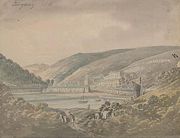
Roman soldiers are known to have visited Torquay at some point during the period when Britain was a part of the Roman Empire, leaving offerings at a strange rock formation in Kent's Cavern, known as 'The Face'. No evidence has been found of Roman settlement in the town.
The first major building in what was to become Torquay was Torre Abbey, a Premonstratensian monastery founded in 1196.[6][7] Torquay remained a minor settlement until the Napoleonic wars, when Torbay was frequently used as a sheltered anchorage by the Channel Fleet, and relatives of officers often visited Torquay. The mild climate of Torquay attracted many visitors who considered the town a convalescence retreat where they could recover from illness away from the cold winters of more Northerly or Easterly locations. The population of Torquay grew rapidly from 838 in 1801, to 11,474 in 1851.
The second phase in the expansion of Torquay began when Torre railway station was opened on 18 December 1848. The improved transport connections resulted in the rapid growth of Torquay at the expense of nearby towns not on Isambard Kingdom Brunel's railways.

The more central Torquay railway station was open on 2 August 1859. After the growth of the preceding decades, Torquay was granted borough status in 1872. Previously regarded as a convalescence retreat, Torquay began to encourage healthy visitors, and 1902 saw the first advertising campaign to market Torquay to summer tourists.
During World War I, military hospitals were sited in Torquay - many survivors from the Battle of Gallipoli recuperated in the town - and it was also used as a troop staging area. In September 1915 King George V and Queen Mary visited. After the war had ended, Great Western Railway launched an advertising campaign to attract tourists to Torquay, and this helped the town grow to a major South coast resort.

During World War II Torquay was regarded as safer than the towns of South East England, and played host to evacuees from the London area, the town did however suffer minor bomb damage during the war, mainly from planes dumping excess loads after participating in the Plymouth Blitz. The last air raid on Torquay took place on 29 May 1944 shortly before the D-Day landings in June and in the months leading up to D-Day thousands of US Army personnel arrived in Torquay with the 3204th Quartermaster Service Company being billeted in Chelston and Cockington. During Operation Overlord more than 23,000 men of the American 4th Infantry Division would depart Torquay for Utah Beach.
The water sport events of the 1948 Summer Olympics were held in Torquay, with the Olympic flame being brought from London to Torre Abbey Gardens.[8]. Although it will not host any Olympic events for the 2012 Summer Olympics, with the sailing taking place in Weymouth, Torbay is looking to host teams as a preparation camp.
Since World War II, the nature of tourism in the United Kingdom has changed significantly. Increasing wealth has meant that holidays abroad are now commonplace, and coastal towns are now more popular for short stays as part of a touring holiday. Recently Torquay has seen an increase in foreign visitors, and is now a major destination for foreign exchange students.
Governance
Torquay is part of Torbay, an administrative area, created in 1968 as a Borough, from the amalgamation of the Boroughs of Torquay, Paignton and Brixham.
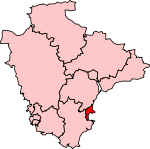
Historically part of the county of Devon, Torbay was made a unitary authority on April 1 1998 making it responsible for its own affairs. For local elections the district is divided into 11 wards, 7 of them in Torquay.
Torbay Council is headed by the first directly elected mayor in the South West region, Conservative candidate Nicholas Bye becoming the first mayor elected under this system in October 2005, under an electoral system which was later described as "a total failure", Bye receiving votes from fewer than 7% of the electorate.[9] He beat Liberal Democrat Nicholas Pannell in the second round of counting with a total of 7,096 votes to Pannell's 5,197. After the election, Bye noted the general apathy towards the concept displayed during the election, stating: "it is quite clear from canvassing that a lot of people did not want an elected mayor."
Torquay, (along with part of Paignton) is in the Torbay parliamentary constituency, created in 1974. The constituency elects one Member of Parliament; currently Adrian Sanders (Liberal Democrat). Torquay, the rest of South West England, and Gibraltar are in the South West England constituency of the European Parliament.
Geography
Torquay is situated on the South West coast of England, forming one third of Torbay, and is primarily on the western side of the bay. It has a mild microclimate, often receiving among the highest hours of sunlight per day in the United Kingdom, winters in the town tend to be mild and wet with above average temperatures. Cabbage trees, also nicknamed 'Torbay Palms' are a notable feature of the area, the trees were introduced into the area in 1820 from New Zealand and since then have flourished, There are currently thousands throughout the town and they contribute significantly to the more Mediterranean than English feel the town has.
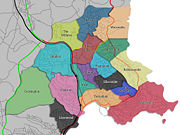
The town is made up of a number of regions that over the years amalgamated into the town of Torquay. The town's historic core consists of the regions of Tormohun, Wellswood, The Warberries, Upton and Ellacombe and is based upon what was once the holdings of the Palk family. In 1900 the regions of Chelston and Livermead, previously part of the Cockington estate owned by the Mallocks were annexed by the town and this was swiftly followed by the absorption of the former borough of Saint Marychuch into the town. In this period Saint Marychurch consisted of more than just present day Saint Marychurch but also the regions of Plainmoor, Watcombe and Babbacombe. Finally in 1928 the Mallocks' last holdings in Cockington were integrated within the town borders. Torquay continued to expand throughout the century leading to the development of Shiphay, Hele Village, Barton and most recently from the 1990s until present day, The Willows giving the town its current layout.
Torquay is also set along a coastline renowned for its beaches, having nine popular beaches. The high standards of water quality and beach facilities mean that many carry coveted awards, including no fewer than three European Blue Flags - more than any other resort in the UK. The main beaches of Torquay are as follows:
- Maidencombe Beach
- Watcombe Beach
- Oddicombe Beach
- Babbacombe Beach
- Anstey's Cove
- Meadfoot Beach
- Torre Abbey Sands
- Corbyn Sands
The town is also noticeable for being the terminus of the Sticklepath Fault line, which runs through the rocks of Devon from Barnstaple Bay to Torquay resulting in infrequent mild earthquakes, the last of which were felt in the 1990s. The fault line emerges in the cliff face which forms part of Rock Walk before going out into the bay itself. On the Rock Walk side is Devonian Limestone on which Warren Road and Fleet Street stand. The other side of the fault line which runs down Belgrave Road is the red sandstone on which Torre Abbey stands, the fault can reach widths up to 500 metres in places.
Transport
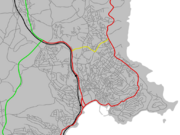
Torquay has two railway stations. Torquay railway station is situated near the sea, close to Torre Abbey Sands. Torre railway station is situated a little inland adjacent to the road leading to Newton Abbot. Not all trains stop at Torre.
Torquay is connected to the UK motorway network by the A380, which traces the outskirts of the town as Hellevoetsluis Way and Hamelin Way, leading to the A38 and then on to the M5 at Exeter. The A3022 branches from the A380, leading into Torquay as Riviera Way, to the seafront as Newton Road and then Avenue Road, and then on to Paignton as Torbay Road. The A379 runs past the harbour to the Babbacombe and St Marychurch areas of Torquay, and then north along the coast to Teignmouth. Two bus routes operated by Stagecoach Devon pass through Torquay - the 'Bayline' number 12 service between Newton Abbot and Brixham, and the X46 service between Exeter and Paignton - while other routes operate within the town.[10]
Economy
Unemployment in Torquay is high at 6.8% - this compares with 3.9% for Devon, and 5.0% for England as a whole.[11]
Many locals were employed in the Pontins holiday centre before it was sold off.
Torquay is also the home of Beverage Brands, the owners of the popular and controversial alcoholic brand, WKD, and was the home of Suttons Seeds until it relocated to the neighbouring town of Paignton in 1998.
Tourism
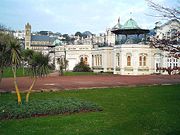
Torquay has numerous tourist attractions, including Kents Cavern, Britain's most important Stone Age site, which was home to early man for some 700,000 years. The floor is composed of several strata, with remains indicating the prehistoric coexistence there of humans and now-extinct animals. The Rev. J. McEnery explored the cave between 1825 and 1829 and put forth the coexistence theory. The cave was extensively explored from 1865 to 1880 by William Pengelly, who found evidence to support McEnery's hypothesis. The caves have attracted many famous people, among them Agatha Christie,[12] Beatrix Potter, King George V and Haile Selassie who was so impressed with his visit that he gave his guide, Leslie Powe a gold sovereign.
Living Coasts, another popular attraction, is built on Beacon Quay, which has existed since 1680. In 1857 the Bath's Saloons complex was built on the promontory overlooking Beacon Cove. This included a ballroom, concert hall and sunlit conservatory and private bathing facilities with, underneath, a large public swimming bath open to the sea. The stone arches of this public bath can still be seen today and have been incorporated into the shop at Living Coasts. Development of the site as a marine animal exhibit was first proposed in the early part of 1999 in response to a call from Torbay Council for submissions from interested parties. The project, developed by Kay Elliott architects, included an exhibit to house marine birds, rather than fish, due to the need to avoid duplicating the exhibits at the National Marine Aquarium in Plymouth. The project was subsequently taken on by Paignton Zoo Environmental Park and named Living Coasts.
Other attractions are the Babbacombe Model Village, which opened in 1963; the Princess Theatre and a large tethered balloon offering aerial views of the town. [13]
Culture
Arts
Torbay Council operates Torbay Arts Base, a forum for the discussion of the arts.[14] Local artists and residents interested in the arts can join the group by registering on the Torbay Arts Database, which also provides access to arts publications The Lighthouse and Torbay Arts Directory.[15][16] In the early years of British cinema, Torquay was home to two production companies, Cairns Torquay Films[17] and Torquay And Paignton Photoplay Productions[18], who in 1920 produced a total of three films between them.
Recently, Devon Films, based in Torquay, has established itself as the Bay's latest film production company. The company financed and produced Stepdad in 2007, starring Ricky Tomlinson and Chris Bisson among others; it was entered into the Cannes Film Festival. A new film Snappers set in Torquay itself and shot on location, starred Caroline Quentin.[19], Bruce Jones and other prominent British television actors, is in pre-production and is due to be released in March 2009.[20]
The Torquay Natural History Society was founded in 1844, and in 1845 opened Torquay Museum, the oldest museum in Devon.[21] In addition to artifacts from Kents Cavern, other local archaeology, information about Agatha Christie, and a replica old farmhouse interior, the museum has galleries dedicated to such diverse topics as ancient Egypt and world jewellery.[22]
The Princess Theatre, which is by the side of the harbour, is owned by Torbay Council and operated by Live Nation. It is Torquay's largest theatre with approximately 1,500 seats and plays host to touring independent production companies.[23] TOADS Theatre Company operates the Little Theatre in Meadfoot in the converted St Mark's Church, hosting both the company's own productions and those of visiting societies.[24] Babbacombe Theatre is located on Babbacombe Downs and describes itself as having the longest running summer season in the country, which lasts nine months.[25]
Media
Torquay as the centre of local government in the Torbay region, is served by two radio stations both with their offices in the town, the oldest is Gemini FM Torbay, part of GCap Media's network of local radio stations, which transmits from the harbourside of the town.[26] The station operates the Gemini Radio Charitable Trust, a registered charity that awards grants to community organisations in the station's broadcast area - a total of more than £529,000 since 1995.[27] Torquay is also served by Palm 105.5FM, owned by the London Media Company and launched in Torbay and the surrounding area in 2006. The station had a difficult start with multiple on air personality changes, has since established itself after widespread local promotion.
The town's local newspaper is called the Herald Express and has been published since 1925 after a merger of two papers. Its catchment area includes towns outside the Bay itself including Newton Abbot and Dartmouth, and there is also a weekly free newspaper known as The Weekender. Former newspapers include the Torquay and Tor General Advertisor and Director, founded in 1839, which in 1853 became The The Torquay Directory and South Devon Journal until 1949, and finally it became The South Devon Journal, which closed in 1973.[28]
Sport
Torquay has a long history of holding sailing events and regattas due to the favourable easterly facing nature of the bay and its popularity in the 19th and 20th centuries; this tradition reached its height in 1948 when the water sport events of the 1948 Summer Olympics were held in Torquay, with the Olympic flame being transferred from London to Torre Abbey Gardens to reside throughout the event.[29]
Outside of naval events, Torquay is represented in the English Conference National Football League by Torquay United F.C.. The team plays their home matches at Plainmoor and have never progressed beyond the third tier of the English leagues. In 2007 they were relegated from the Football League after 80 years of membership and currently play in the Conference National; this downfall came just three years after their most recent promotion from the league's basement division and ultimately led to a change in ownership of the club to a consortium of local businessmen and fans. Notable former managers of the club include Frank O'Farrell who'd later go on to manage Leicester City and Manchester United, David Webb, Cyril Knowles, Neil Warnock and Roy McFarland. Notable former players include Lee Sharpe, Neville Southall, Garry Nelson and Eddie Kelly.
The town also houses three major football teams from the local non-league scene, including Hele Rovers, Kingskerswell & Chelston and Upton Athletic, all of whom compete in the South Devon League.
Torquay is represented in the sport of rugby by Torquay Athletic Rugby Football Club, who compete in the South West Division Two rugby league, which is five leagues below the Guinness Premiership.
Torquay also hosted the World Snooker European Open 2003 at the Palace Hotel, which was won by Ronnie O'Sullivan, In the same year, the Palace Hotel also hosted the World Snooker Championship Qualifiers. Recently the resort has become popular among the Powerboat community and has held various national championships in various classes over the past few years.
Torquay in English culture
| Notable people born in Torquay | |
|---|---|
| 1821 | Richard Burton, explorer and linguist[30] |
| 1867 | Percy Fawcett, archaeologist and explorer[31] |
| 1890 | Agatha Christie, best-selling crime novelist[12] |
| 1937 | Peter Cook, writer and comedian[32] |
| 1947 | Martin Turner, Wishbone Ash founder[33] |
| 1949 | Roger Deakins, cinematographer[34] |
| 1972 | Miranda Hart, actress and comedienne[35] |
| 1980 | Layla Jade, erotic actress[36] |
A number of sketches for the Monty Python's Flying Circus television show (1969-73) were filmed on location in and around both Torquay and neighbouring Paignton. It was while staying in Torquay at the Gleneagles Hotel with the Python team in 1971, that John Cleese found inspiration for Fawlty Towers (1975,1979), a popular sitcom.[37] Incidents during the Pythons' stay are said to include the owner, Donald Sinclair, having thrown Eric Idle's suitcase out of the window thinking it was a bomb. Cleese later described the eccentric owner as, "the most wonderfully rude man I have ever met", although Mr. Sinclair's widow has since said her husband was totally misrepresented in the comedy.[38] Although the exterior of the hotel itself was the Wooburn Grange Country Club in Buckinghamshire, some location filming for Fawlty Towers was actually done in Cambridge, Berkshire and Bedfordshire. In the episode "Gourmet Night" there is film footage of Basil in a shopping area where shopfronts show Torquay addresses and phone numbers. As of 2007[update], Torbay Council were considering plans to erect a statue of characters from the show by the harbour.[39][40]
In 1979 the town was again the site of filming, when the Ray Winstone, BAFTA nominated drama That Summer was both set in and filmed around the town.
In addition to its association with the Pythons, Torquay is also the setting for the 2003 movie Blackball staring Paul Kaye and Vince Vaughn. The movie is about Cliff Starkey who is the Bad Boy of Lawn Bowls.[41]
Torquay has a strong literary tradition with two classic pieces of English literature Oscar Wilde's A Woman of No Importance and Sir Arthur Conan Doyle's The Hound of the Baskervilles reputed to have been written while their authors were staying in Torquay.
The town also has an unusual history of providing models for the Glamour and Erotic industries with Glamour Model Lauren Pope, Popular Lad's mag pin up Natasha Mealey who has appeared in publications such as FHM and Zoo, and erotic actress Layla Jade all having being born in the town and lived in it for varying degrees of time.
Torquay is also the home of the co-presenter of popular Sky Sports One program Soccer AM Helen Chamberlain. Los Angeles radio personality Richard Blade is originally from Torquay. International catwalk model Lily Cole was born in Torquay but grew up in the British capital city of London..
Demographics
The 2001 census confirmed Torquay's reputation as a retirement town, with 26% of the population of 63,998 over sixty years old, compared to a figure of 21% for England as a whole. Those under twenty years old accounted for 23% of the population, compared to a figure of 25% for the whole of England.[42]
The following statistics are for the whole of Torbay, including Paignton and Brixham.
| Marital status | Number of people |
|---|---|
| Single (never married) | 26,880 |
| Married or re-married | 53,327 |
| Separated or divorced | 14,273 |
| Widowed | 11,905 |
| Religion | Number of people |
|---|---|
| Christian | 98,820 |
| Buddhist | 196 |
| Hindu | 66 |
| Jewish | 159 |
| Muslim | 341 |
| Sikh | 50 |
| Other | 476 |
| No religion | 19,345 |
| Religion not stated | 10,253 |
Social issues
Politics
Torquay, as one of the three main towns of Torbay, is run by Torbay Council which has its town hall at the top of the Torquay high street. Currently the Conservative Party is the party in power, with the Liberal Democrats in a distant second place and Independent candidates, a very distant third. [43]
From the 1920s until 1997 Torbay constituency was a safe Tory seat until Adrian Sanders overturned spy novel writer Rupert Allason's majority by just 12 votes, widened to 6,708 in 2001. During the 2005 general election, Conservative leader Michael Howard visited the town. However, Sanders retained the seat with 40.8% of the votes (19,317, down from 23,012 in 2001). A swing of 9.7% away from the Liberal Democrats was split between the Conservatives (with a 4.9% swing), Labour - who gained a substantial increase in their vote as support for Lib Dems in 1997 and 2001 moved back and the United Kingdom Independence Party (UKIP), whose candidate Graham Booth improved on his deposit-losing 2001 performance with a 4.7% increase in his vote.
In 2005, a referendum was held to appoint Torbay's first Elected Mayor. In the ensuing election in October 2005, the winning candidate was a former Liberal Parliamentary Candidate, Nicholas Bye, who won the election as a Conservative.
Education
There are five main secondary schools in the town. One is Torquay Community College, previously known as Audley Park. This school has had its troubles in the past and has in the past two years come out of governmental special measures. Its 2004 exam results are available Here
The other mainstream secondary school in Torquay is Westlands Secondary School and Technology College. This is a combined secondary college and 6th form that takes students of all variations and has recently moved to a brand new modern building. Its 2004 exam results are available Here
Torquay's other three state secondary schools are more selective. They are St Cuthbert Mayne School, a secondary school exclusively open to followers of the Roman Catholic and Church of England faiths, and Torquay Boys' Grammar School and Torquay Grammar School for Girls which are available only to those that pass the 11+ intelligence test and the schools' own standardised test. The 2004 results for St Cuthbert Mayne school are available here, the Boys' Grammar School results here and finally the Girls' Grammar School here. There are also a number of private schools in the area including Stoodley Knowle School and the Abbey School.
For further education, students can either go to one of the sixth forms at the previous mentioned Westlands, St Cuthbert's Mayne or Grammar schools, or they can go to South Devon College which is based in Long Road in Paignton on a new campus that fully opened in January 2006.
Should students pass through school or college and wish to continue in their education at university, they will have to leave Torquay. Should they wish to continue living in Torquay they have the option of applying to either Exeter or Plymouth universities, each roughly an hour train journey from Torquay train station.
Crime
| Offences | Total | Rate per 1,000 population | Average rate per 1,000 population in England & Wales |
|---|---|---|---|
| Violence Against The Person | 1,408 | 11.2 | 10.9 |
| Sexual Offences | 104 | 0.8 | 0.7 |
| Robbery Offences | 72 | 0.6 | 1.5 |
| Burglary Dwelling Offences | 1,014 | 8.0 | 6.5 |
| Theft Of Motor Vehicle | 293 | 2.3 | 5.0 |
| Theft From Vehicle | 1,352 | 10.7 | 10.9 |
Information taken from 2001/2002 crime figures in Torbay, available Here
Healthcare
Torquay's healthcare needs are seen to by NHS-run Torbay hospital which is situated on the main road out of Torquay and the private, non-emergency Mount Stuart on St Vincents Road.
Twin towns
Because it is part of Torbay, Torquay has two twin towns. The year each relationship was formed is shown in parentheses below.
|
References
- ↑ "Key Statistics for Tobray — May 2005" (PDF). Census 2001 2. The Consultation and Research Team, Torbay Council. Retrieved on 2008-11-28.
- ↑ The New English Riviera, The Mayor's Vision For A New Torbay, Torbay Council Publication, 2007
- ↑ Percy Russell, A History Of Torquay (Torquay: Devonshire Press Limited, 1960), 7-8
- ↑ John R. Pike, Torquay (Torquay: Torbay Borough Council Printing Services, 1994), 5-6
- ↑ "Jawbone hints at earliest Britons". news.bbc.co.uk. Retrieved on 2006-11-07.
- ↑ Russell, 19
- ↑ Pike, 6
- ↑ Russell, 199
- ↑ "BBC NEWS". news.bbc.co.uk. Retrieved on 2008-04-03.
- ↑ "Devon - Timetables". Stagecoach Group. Retrieved on 2006-11-01.
- ↑ Office for National Statistics, "Table CAS021: Economic activity by sex and limiting long-term illness" in United Kingdom Census 2001 (London: Office for National Statistics, 2001)
- ↑ 12.0 12.1 Agatha Christie (1977), Autobiography
- ↑ http://www.englishriviera.co.uk/site/attractions/torquay-hi-flyer-balloon-p628493
- ↑ ""Torbay Arts Base", Torbay Council". torbay.gov.uk. Retrieved on 2006-11-03. (link dead 2008-04-03)
- ↑ ""Torbay Arts Database", Torbay Council". torbay.gov.uk. Retrieved on 2006-11-03.
- ↑ ""Torbay Arts Directory", Torbay Council". torbay.gov.uk. Retrieved on 2006-11-03. (link dead 2008-04-03)
- ↑ Cairns Torquay Films
- ↑ Torquay & Paignton Photoplay Productions
- ↑ "TV Star Lined up for Bay Comedy". www.thisissouthdevon.co.uk. Retrieved on 2008-04-03.
- ↑ "Devon Films : Creators of Snappers, a British romantic comedy". www.devonfilms.com. Retrieved on 2008-04-03.
- ↑ "Torquay Museum - About Us". www.torquaymuseum.org. Retrieved on 2008-04-03.
- ↑ "Torquay Museum - See the Museum". www.torquaymuseum.org. Retrieved on 2008-04-03.
- ↑ "Princess Theatre : Official Website". www.livenationtheatres.co.uk. Retrieved on 2008-04-03.
- ↑ "Little Theatre in Torquay, Devon". www.toadstheatre.co.uk. Retrieved on 2008-04-03.
- ↑ "Babbacombe Theatre - Let us entertain you ....". www.babbacombe-theatre.com. Retrieved on 2008-04-03.
- ↑ "FAQs - Gemini Torquay". www.geminitorbay.co.uk. Retrieved on 2008-04-03.
- ↑ "Charitable Trust - Gemini Exeter". www.geminiexeter.co.uk. Retrieved on 2008-04-03.
- ↑ Devon Library and Information Services (06 May 2005). "Devon newspaper bibliography: Torquay". Devon County council. Retrieved on 4 December 2008.
- ↑ Russell, 199
- ↑ "BBC - Devon - Features - Explorer and word inventor". www.bbc.co.uk. Retrieved on 2006-10-09.
- ↑ "Percy (Harrison) Fawcett Biography - Biography.com". The Biography Channel. Retrieved on 2006-10-09.
- ↑ "Peter Cook (I)". Internet Movie Database Incorporated. Retrieved on 2006-10-09.
- ↑ "Wishbone Ash - The Band - Past Members". www.wishboneash.com. Retrieved on 2006-10-08.
- ↑ "Roger Deakins". Internet Movie Database Incorporated. Retrieved on 2006-10-09.
- ↑ "Miranda Hart". Internet Movie Database Incorporated. Retrieved on 2006-10-09.
- ↑ "Layla Jade". Internet Movie Database Incorporated. Retrieved on 2006-10-09.
- ↑ "BBC - Comedy - Fawlty Towers". www.bbc.co.uk. Retrieved on 2006-10-29.
- ↑ Richard Savill. "My husband was not like Basil". Telegraph Media Group. Retrieved on 2007-01-21.
- ↑ "Just add Basil for Bay tourist appeal", Weekender Torbay Edition, 2006-09-21
- ↑ "Basil in bronze", Chortle (2007-01-20). Retrieved on 2007-01-21.
- ↑ "Blackball (2003)". Internet Movie Database Incorporated. Retrieved on 2007-01-21.
- ↑ Office for National Statistics (2001), United Kingdom Census 2001
- ↑ BBC NEWS | Election 2007 | Local Council Elections | Torbay council
See also
- Babbacombe Cliff Railway
- Kents Cavern
External links
- Torquay at the Open Directory Project
- Wikitravel - Torquay
Tourism
History
|
||||||||||||||||||||
